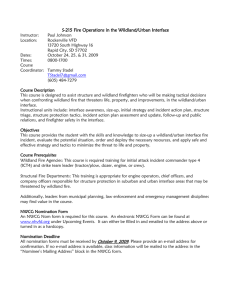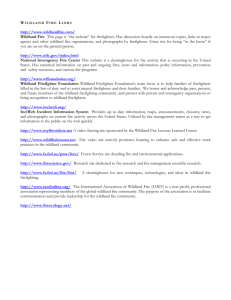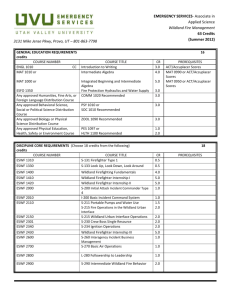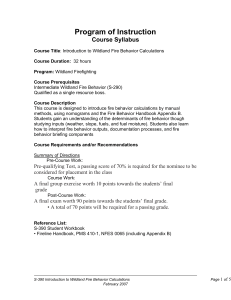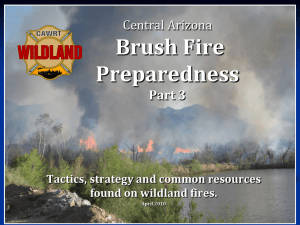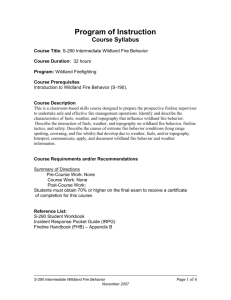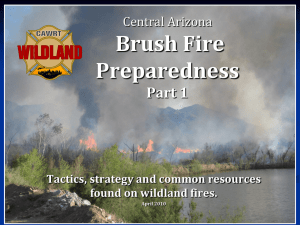External OE Update - Operating Experience
advertisement
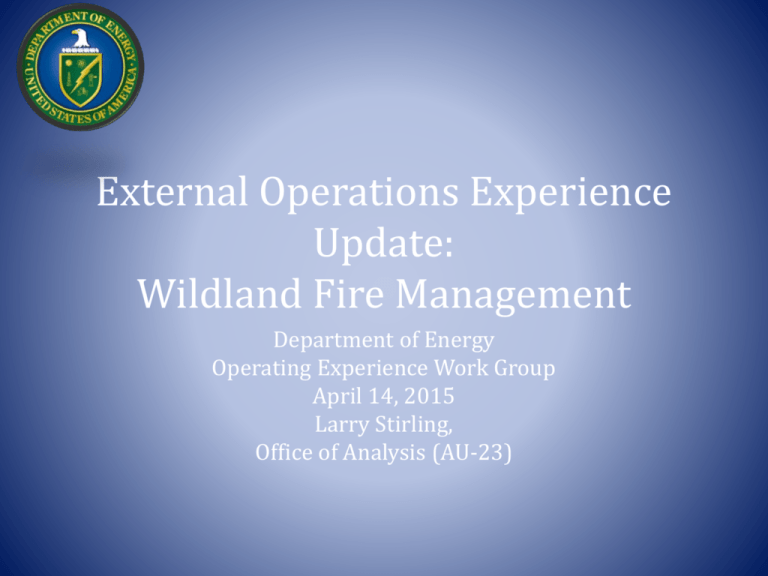
External Operations Experience Update: Wildland Fire Management Department of Energy Operating Experience Work Group April 14, 2015 Larry Stirling, Office of Analysis (AU-23) Wildland Fire Management • Fire Season is approaching • Extensive and systematic framework established primarily by Department of Agriculture and Department of Interior through Wildland Fire Leadership Council (WFLC) 2 Wildand Fire Management • Guidance for Implementation of Federal Wildland Fire Management Policy, February 13, 2009 • Approved by Fire Executive Council 3 Wildland Fire Management 1. Agencies will use common standards for all aspects of their fire management programs to facilitate effective 2. Agencies will review, update, and develop agreements that clarify the jurisdictional inter-relationships and define the roles and responsibilities among local, state, tribal and federal fire protection entities. 3. Responses to wildland fire will be coordinated across levels of government regardless of the jurisdiction at the ignition source. 4 Wildland Fire Management 4. Fire management planning will be intergovernmental in scope and developed on a landscape scale. 5. Wildland fire is a general term describing any non-structure fire that occurs in the wildland. a. Wildfires – Unplanned ignitions or prescribed fires that are declared wildfires b. Prescribed Fires - Planned ignitions. 6. A wildland fire may be concurrently managed for one or more objectives and objectives can change as the fire spreads across the landscape. Objectives are affected by changes in fuels, weather, topography; varying social understanding and tolerance; and involvement of other governmental jurisdictions having different missions and objectives. 5 Wildland Fire Management 7. Management response to a wildland fire on federal land is based on objectives established in the applicable Land/ Resource Management Plan and/or the Fire Management Plan. 8. Initial action on human-caused wildfire will be to suppress the fire at the lowest cost with the fewest negative consequences with respect to firefighter and public safety. 9. Managers will use a decision support process to guide and document wildfire management decisions. The process will provide situational assessment, analyze hazards and risk, define implementation actions, and document decisions and rationale for those decisions. 6 Wildland Fire Management Guiding Principles 1. Firefighter and public safety is the first priority in every fire management activity. 2. The role of wildland fire as an essential ecological process and natural change agent will be incorporated into the planning process. Federal agency land and resource management plans set the objectives for the use and desired future condition of the various public lands. 3. Fire Management Plans, programs, and activities support land and resource management plans and their implementation. 7 Wildland Fire Management 4. Sound risk management is a foundation for all fire management activities. Risks and uncertainties relating to fire management activities must be understood, analyzed, communicated, and managed as they relate to the cost of either doing or not doing an activity. Net gains to the public benefit will be an important component of decisions. 5. Fire management programs and activities are economically viable, based upon values to be protected, costs, and land and resource management objectives. Federal agency administrators are adjusting and reorganizing programs to reduce costs and increase efficiencies. As part of this process, investments in fire management activities must be evaluated against other agency programs in order to effectively accomplish the overall mission, set short- and long-term priorities, and clarify management accountability. 6. Fire Management Plans and activities are based upon the best available science. Knowledge and experience are developed among all federal wildland fire management agencies. An active fire research program combined with interagency collaboration provides the means to make these tools available to all fire managers. 8 Wildland Fire Management 7. Fire Management Plans and activities incorporate public health and environmental quality considerations. 8. Federal, State, tribal, local, interagency, and international coordination and cooperation are essential. Increasing costs and smaller work forces require that public agencies pool their human resources to successfully deal with the ever increasing and more complex fire management tasks. Full collaboration among federal wildland fire management agencies and between the federal wildland fire management agencies and international, State, tribal, and local governments and private entities result in a mobile fire management work force available for the full range of public needs. 9. Standardization of policies and procedures among federal wildland fire management agencies is an ongoing objective. Consistency of plans and operations provides the fundamental platform upon which federal wildland fire management agencies can cooperate, integrate fire activities across agency boundaries, and provide leadership for cooperation with State, tribal, and local fire management organizations 9 References • Managing the Impact of Wildfires on Communities and the Environment A Report to the President In Response to the Wildfires of 2000, September 8, 2000 http://www.forestsandrangelands.gov/resources/reports/documents/2001/ 8-20-en.pdf • Review and Update of the 1995 Federal Wildland Fire Management Policy (January 2001) is the primary interagency wildland fire policy document. (DOE participated in the development): https://www.nifc.gov/PIO_bb/Policy/FederalWildlandFireManagementPolicy_ 2001.pdf • The Interagency Strategy for the Implementation of Federal Wildland Fire Management Policy (June 20, 2003) was developed and approved under the authority of the Wildland Fire Leadership Council (WFLC) to set forth direction for consistent implementation of the federal fire policy: http://www.sierraforestlegacy.org/Resources/Community/SmokeManagemen t/AirQualityPolicy/FedWldFireMgmtPolicy.pdf 10 References • Interagency Prescribed Fire: Planned and Implementation Procedures Reference Guide, September 2006: http://www.fws.gov/mountainprairie/fire/PDF's/rxfireguide.pdf • Modification of Federal Wildland Fire Policy Guidance. Issued May 2, 2008 by the WFLC. This memorandum directed federal agencies to test and implement new guidelines for wildland fire management. • Guidance for Implementation of Federal Wildland Fire Management Policy, February 13, 2009: https://www.nifc.gov/policies/policies_documents/GIFWFMP.pdf • • Interagency Prescribed Fire Planning and Implementation Procedures Guide, April 2014: http://www.nwcg.gov/pms/RxFire/pms484.pdf • The National Strategy: The Final Phase in the development of the National Cohesive Wildland Fire Management Strategy: http://www.doi.gov/news/loader.cfm?csModule=security/getfile&pageid=526008 11 References • Forging a Science-Based National Forest Fire Policy: http://issues.org/201/franklin/ By Jame Agee and Jerry Franklin Revisions to the Annual Operating Plans for Master Cooperative Fire and Stafford Act Agreements due to Implementation of Revised Guidance for the Implementation of Federal Wildland Fire Management Policy, National Wildfire Coordinating Group, April, 2009: http://www.nwcg.gov/general/memos/nwcg-009-2009.pdf 12 Resources • USDA Forest Service: Fire Effects Information System (FEIS) The Fire Effects Information System is an online collection of reviews of the scientific literature about fire effects on plants and animals and about fire regimes of plant communities in the United States. FEIS reviews are based on thorough literature searches, often supplemented with insights from field scientists and managers. FEIS provides reviews that are efficient to use, thoroughly documented, and defensible. Approximately 15 to 30 new or revised reviews are published in FEIS each year. http://www.feis-crs.org/beta/ • Rocky Mountain Research Station The Rocky Mountain Research Station is one of seven regional units that make up the USDA Forest Service Research and Development organization – the most extensive natural resources research organization in the world. The core geography of the Station is the twelve non-coastal western states. http://www.fs.fed.us/rmrs/ Reports on annual research accomplishments (e.g., Fire, Fuel, and Smoke Science Program 2014 Research Accomplishments) are available http://wwwnew.firelab.org/sites/default/files/images/downloads/FFS_AnnualReport_FY2014.pdf • • Conducted in association with the Missoula Fire Sciences Laboratory 13 Resources APPS on Rocky Mountain Research Station (RMRS) FRAMES: Fire Research and Management Exchange System, University of Idaho and University of Montana FRAMES provides a method of exchanging information and transferring technology among wildland fire researchers, managers, and other stakeholders in an online environment. The FRAMES portal provides essential searchable information, a platform for data sharing and storage, development of new tools, and support to federal wildland fire management agencies in the United States throughout the various stages of wildland fire, including planning, operation, and post-fire monitoring. Online courses https://www.frames.gov/ • BehavePlus The BehavePlus fire modeling system (link is external) is a Windows®-based computer program that can be used for any fire management application that involves modeling fire behavior and fire effects. https://www.frames.gov/partner-sites/behaveplus/home/ 14 Resources • FARSITE FARSITE is a fire growth simulation modeling system. It uses spatial information on topography and fuels along with weather and wind files. It incorporates existing models for surface fire, crown fire, spotting, postfrontal combustion, and fire acceleration into a 2-dimensional fire growth model. http://firelab.org/project/farsite • Landfire (USDA RMRS and USDOI) LANDFIRE is a program that provides over 20 national geo-spatial layers (e.g. vegetation, fuel, disturbance, etc.), databases, and ecological models that are available to the public for the US and insular areas. http://www.landfire.gov/ • USDA Forest Service: Fire Effects Information System (FEIS) The Fire Effects Information System is an online collection of reviews of the scientific literature about fire effects on plants and animals and about fire regimes of plant communities in the United States. FEIS reviews are based on thorough literature searches, often supplemented with insights from field scientists and managers. FEIS provides reviews that are efficient to use, thoroughly documented, and defensible. Approximately 15 to 30 new or revised reviews are published in FEIS each year. http://www.feiscrs.org/beta/ 15 Resources National Fire Danger Rating System • In 2014, RMRS fire danger rating system developers sought and gained approval to update the U.S. National Fire Danger Rating System (NFDRS). This system has remained static for nearly 40 years, despite many scientific and technological advances that could significantly improve the system. These system updates have been approved by the Fire Danger Subcommittee of the National Wildfire Coordinating Group (NWCG) and by the NWCG Executive Board. The new system will be implemented and tested over the next two years and is expected to be fully operational in January 2016. http://firelab.org/project/national-fire-danger-rating-system National Digital Forecast Data Base (NDFD) Fire Danger Point Forecast Tool A simple, point forecast interface that produces seven day fire danger forecasts from the National Digital Forecast Database http://www.wfas.net/ • 16 Resources • Weather Information Management System The Weather Information Management System (WIMS) is a mission critical, national system, managed and maintained by USDA, Forest Service's Fire and Aviation Management (F&AM) branch for interagency use. WIMS serves as the processor for the National Fire Danger Rating System (NFDRS), using weather observations and NWS forecast to generate indices, including Burning Index (BI), Energy Release component (ERC), Staffing Level (SL) and the Adjective Rating http://firelab.org/project/weather-information-management-system • WindNinja WindNinja is a computer program that computes spatially varying wind fields for wildland fire and other applications requiring high resolution wind prediction in complex terrain. http://firelab.org/project/windninja • WindWizard WindWizard is a computer model designed to calculate the effect of topography on local wind flow. Outputs from the model are wind speed and direction every 100-300ft over the terrain. Simulations can be completed on a laptop computer in about 1 hour. http://firelab.org/project/windwizard 17 Resources • Treesearch (United States Department of Agriculture - USDA) Treesearch is an online system for sharing free, full text publications by Research and Development scientists in the US Forest Service. Included in Treesearch are scholarly works published by the agency as well as those published by others, including papers appearing in journals, conference proceedings, or books. All publications appearing in Treesearch are based on peer reviewed research to make sure they provide the best scientific information possible. http://www.treesearch.fs.fed.us/ • Research Data Archive (USDA) Archive preserves and publishes short and long-term research data collected from studies funded by: Forest Service Research and Development (FSR&D); Joint Fire Science Program (JFSR); andAldo Leopold Wilderness Research Institute (ALWRI) http://www.fs.usda.gov/rds/archive/ 18 Resources • Fire Modeling Institute FMI helps facilitate efficient science delivery to fire management. Its mission is to connect fire managers with technical experts and scientists, using the latest fire science and fire modeling systems to respond to fire-related resource management needs. http://firelab.org/about-fmi-0 • National Fire Decision Support Center The NFDSC is a collaborative effort between Fire and Aviation Management and Research and Development. It is located at the National Interagency Fire Center and provides a key link between wildland fire science development and the appropriate application of that science. http://www.wfmrda.nwcg.gov/nfdsc.php Wildland Fire Management Research, Development, and Application (WFM RD&A) Program Created to promote application of wildland fire scientific knowledge; develop decision support tools; and provide science application services to the interagency wildland fire community. http://www.wfmrda.nwcg.gov/ • 19 Resources • Fire Danger Rating – The U.S. National Fire Danger Rating System (NFDRS) produces indices such as Energy Release Component (ERC) that indicate the potential for fire activity. – FireFamilyPlus, an agency independent Windows application is a primary tool in the fire behavior/danger suite of programs which share data and models that are used in a variety of environments to address a range of business needs – http://firelab.org/project/firefamilyplus 20 Resources • NDFD Fire Danger Point Forecast Tool – Internet-based system, – Used to assess the current state of the fire season, and more, including national and regional maps of fire danger – Provides daily maps of dry lightning – Provides access to experimental and emerging technologies that improve fire season assessment capabilities • Uses weather data from more than 2000 fire weather stations • http://www.wfas.net 21 Resources • North Atlantic Fire Science Exchange http://www.nrs.fs.fed.us/disturbance/fire/nafse/ • Lake States Fire Science Consortium http://lakestatesfiresci.net/ • Tallgrass Prairie and Oak savanna Fire Science Consortium http://www.tposfirescience.org/ • Oak Woodlands & Forests Fire Consortium http://www.oakfirescience.com/ 22 Resources • National Interagency Fire Center • The National Interagency Fire Center (NIFC), located in Boise, Idaho, is the nation's support center for wildland firefighting. Eight different agencies and organizations are part NIFC http://www.nifc.gov/ 23 Resources • Missoula Technology and Development Center The Missoula Technology and Development Center (MTDC) began as the support facility for Forest Service fire management in the late 1940's, when a small group started developing techniques for parachuting men and cargo. In the early 1960's, the center's role was expanded to a Service-wide technical center with a nationwide program that now encompasses all Forest Service equipment needs. Today, MTDC works with Federal and State agencies, universities, private firms, and research groups to meet its responsibilities to resource managers. http://www.fs.fed.us/eng/techdev/mtdc.htm 24 Resources • National Advanced Fire and Resource Institute A national level training center serving the interagency wildland fire community through the development and implementation of fire, fuels, resource and incident management skills and educational processes http://www.nafri.gov/ • Earth Observatory, NASA Goddard Space Flight Center Global Fire Monitoring http://earthobservatory.nasa.gov/Features/GlobalFire/ 25 Resources • Joint Fire Science Program The Joint Fire Science Program funds scientific research on wildland fires and distributes results to help policymakers, fire managers and practitioners make sound decisions. http://www.firescience.gov/ • Remote Automatic Weather Stations (RAWS) – National Interagency Fire Center There are nearly 2,200 interagency Remote Automatic Weather Stations (RAWS) strategically located throughout the United States. These stations monitor the weather and provide weather data that assists land management agencies with a variety of projects such as monitoring air quality, rating fire danger, and providing information for research applications. http://raws.fam.nwcg.gov/ 26 Resources • San Dimas Technology & Development Center (USDA Forest Service) The San Dimas Technology and Development Center (SDTDC) was established in 1945 to standardize fire equipment, and serves emerging technological requirements of the Forest Service and its cooperators. http://www.fs.fed.us/eng/techdev/sdtdc.htm • Wildland Fire Chemicals (USDA Forest Service) Provides technical support to Forest Service Fire and Aviation Management (F&AM) on matters relating to fire chemical products. http://www.fs.fed.us/rm/fire/wfcs/index.htm#qpl 27 Resources • ForWarn Satellite-Based Change Recognition and Tracking ForWarn provides near-real-time tracking of vegetation changes across landscapes in the United States. Useful for both monitoring disturbance events as well as year-to-year variability, derived products can also be used to develop insights into seasonal and inter-annual dynamics. http://forwarn.forestthreats.org/ • National Weather Service, National Operational Hydrologic Remote Sensing Center National Snow Analysis Maps http://www.nohrsc.noaa.gov/nsa/ 28 Resources • USDA Forest Service Remote Sensing Applications Center (RSAC), Active Fire Mapping Program http://activefiremaps.fs.fed.us/ • Monitoring Trends in Burn Severity A multi-year project designed to consistently map the burn severity and perimeters of fires across all lands of the United States from 1984 and beyond. http://www.mtbs.gov/index.html 29 Resources • GEOMAC – Geospatial Multi-Agency Coordination, Wildland Fire Support The Geospatial Multi-Agency Coordination or GeoMAC, is an internet-based mapping application originally designed for fire managers to access online maps of current fire locations and perimeters in the United States. Using a standard web browser, fire personnel can view this information to pinpoint the affected areas. With the growing concern of western wildland fires in the summer of 2000, this application also became available to the public. http://www.geomac.gov/ • Forest Health Technology Enterprise Team Develops and delivers forest health technology services to field personnel in public and private organizations in support of the Forest Service's land ethic, to promote the sustainability of ecosystems by ensuring their health, diversity, and productivity. http://www.fs.fed.us/foresthealth/technology/ 30 Resources • USGS Water Data for the Nation This web site serves current and historical data. Data are retrieved by category of data, such as surface water, groundwater, or water quality, and by geographic area. Subsequent pages allow further refinement by selecting specific information and by defining the output desired. http://waterdata.usgs.gov/nwis • National Oceanographic and Atmospheric Administration, Storm Prediction Center This page has the United States severe report database (tornadoes 19502014, hail/wind 1955-2014), converted into shapefile (.shp) file format as well as a Geographic Information System (GIS) database. The data can be viewed in graphical, tabular, and statistical formats depending on enduser programs http://www.spc.noaa.gov/gis/svrgis/ 31 Resources • U.S. Drought Monitor This climatic stress mapping effort shows the location of dry, moderate, severe extreme and exceptional drought in near real time. Both current and archived data are available. http://droughtmonitor.unl.edu/ • Vegetation Drought Response Index The Vegetation Drought Response Index (VegDRI) project relates near real time weather conditions to effects on the ground. These supportive data show climate stress and meteorological data such as days with precipitation. http://vegdri.unl.edu/ 32 Resources • RAWS USA Climate Archive Archived and near real time weather data for rural stations are available through the Remote Automated Weather station network. These have been useful for documenting daily temperature extremes in fall and spring. http://www.raws.dri.edu/ • Historic Palmer Drought Indices Monthly maps of drought conditions in the contiguous U.S. as measured by the Palmer Drought Severity Index, Palmer Hydrological Drought Index, Palmer Modified Drought Index, and Palmer Z-Index (Palmer, 1965) are provided for January 1900— February 2015. http://www.ncdc.noaa.gov/temp-and-precip/drought/historicalpalmers/ 33 Resources Landscape Management System (LMS) • A cooperative project between the University of Washington, College of Forest Resources, Silviculture Laboratory, Yale University School of Forestry and Environmental Studies. • Its purpose is to develop the concepts and tools needed to help forests provide the wide range of values people want -- including commodities, wildlife habitat, fire safety, employment, and carbon sequestration. http://landscapemanagementsystem.org/ 34 Resources • National Fire Protection Association NFPA 1141, Standard for Fire Protection Infrastructure for Land Development in Suburban and Rural Areas This standard covers the requirements for the fire protection infrastructure in suburban and rural areas where there is an intended change of land use or intended land development. NFPA 1142: Standard on Water Supplies for Suburban and Rural Fire Fighting This standard identifies a method of determining the minimum requirements for alternative water supplies for structural fire-fighting purposes in areas where the authority having jurisdiction determines that adequate and reliable water supply systems for fire-fighting purposes do not otherwise exist. 35 Resources NFPA 1143: Standard for Wildland Fire Management This standard provides minimum requirements to fire protection organizations on the management of wildland fire, including prevention, mitigation, preparation, and suppression. NFPA 1144: Standard for Reducing Structure Ignition Hazards from Wildland Fire This standard provides a methodology for assessing wildland fire ignition hazards around existing structures, residential developments, and subdivisions and improved property or planned property improvement that will be located in a wildland/ urban interface area, and provides minimum requirements for new construction to reduce the potential of structure ignition from wildand fires. http://www.nfpa.org/codes-and-standards/document-information-pages 36 What next? • Steps are up to you. • Consider reviewing wildland fire management programs, plans, documents, coordination actions as needed. • Review, as appropriate, references and resources. • Take appropriate actions. • Be prepared for the fire season. 37 • Contact Information: Larry Stirling Office of Analysis (AU-23) 202-586-2417 john.stirling@hq.doe.gov 38
